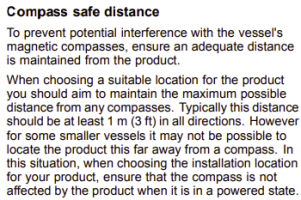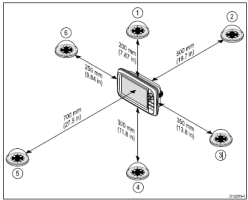You are using an out of date browser. It may not display this or other websites correctly.
You should upgrade or use an alternative browser.
You should upgrade or use an alternative browser.
E34-2 Compass Safe Distance and NavPod/MFD
- Thread starter Phr3d
- Start date
For what it's worth, I don't see any interference from a typical chartplotter.
But I consider the whisky compass to be a decoration most useful for a quick glance at the heading, or for steering a heading. There are numerous GPS compasses on most boats, including the iPhone with its magnetometer, should accuracy need to be confirmed.
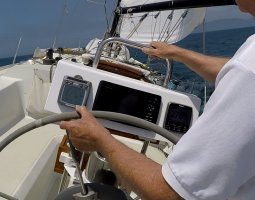
But I consider the whisky compass to be a decoration most useful for a quick glance at the heading, or for steering a heading. There are numerous GPS compasses on most boats, including the iPhone with its magnetometer, should accuracy need to be confirmed.

I will take the risky and frisky action and (slightly) disagree with the Master. 
I used a real-world exercise when choosing our current chart plotter. I was allowed to borrow several new plotters from the local marine electronics store, and (handing them with paranoid and utmost care...) trial fit/position each one above our compass under the ss guard. (I did have the guard extended on both legs to give more room for the frp shelf and 9" plotter.)
FWIW most of these devices have a "compass safe" distance specified deep in their PDF install instructions. A real marine electronics shop sales person will discuss it with you, and a typical sales droid at a big box marine store will not - and often knows not.
Several install manuals I have viewed for differing brands mentions 19 inches as a safe distance. Closer might be good enough, and their estimate is likely a compromise between their engineers and their liability lawyers.
Only the one model with a friction-catch chip door did not visibly "move the needle". It's a Lowrance and was from the same parent company that produces several very similar brands for differing boating "markets", and the shop said that the electronics were very similar.
I could have chosen a Simrad or B&G unit, based on similar features. However, those had powerful little magnets holding their chip door closed.
If having to fall back to old-fashioned analog navigation when power fails, one could always just unplug and unmount the plotter and store it below decks, I acknowledge. Nothing wrong with any of your choices, but be sure you understand the ramifications and limitations. (Insert Clint Eastwood movie quote at this point!)
Edit: the internal circuitry itself -when powered up -may also cause a magnetic compass error at some close distance, and that's really a separate concern from the gross effect of the permanent magnet problem. Something else to discuss with a technician.
I used a real-world exercise when choosing our current chart plotter. I was allowed to borrow several new plotters from the local marine electronics store, and (handing them with paranoid and utmost care...) trial fit/position each one above our compass under the ss guard. (I did have the guard extended on both legs to give more room for the frp shelf and 9" plotter.)
FWIW most of these devices have a "compass safe" distance specified deep in their PDF install instructions. A real marine electronics shop sales person will discuss it with you, and a typical sales droid at a big box marine store will not - and often knows not.
Several install manuals I have viewed for differing brands mentions 19 inches as a safe distance. Closer might be good enough, and their estimate is likely a compromise between their engineers and their liability lawyers.
Only the one model with a friction-catch chip door did not visibly "move the needle". It's a Lowrance and was from the same parent company that produces several very similar brands for differing boating "markets", and the shop said that the electronics were very similar.
I could have chosen a Simrad or B&G unit, based on similar features. However, those had powerful little magnets holding their chip door closed.
If having to fall back to old-fashioned analog navigation when power fails, one could always just unplug and unmount the plotter and store it below decks, I acknowledge. Nothing wrong with any of your choices, but be sure you understand the ramifications and limitations. (Insert Clint Eastwood movie quote at this point!)
Edit: the internal circuitry itself -when powered up -may also cause a magnetic compass error at some close distance, and that's really a separate concern from the gross effect of the permanent magnet problem. Something else to discuss with a technician.
peaman
Sustaining Member
I've been there. I was unaware of a published "compass-safe distance" until I discovered that my B&G Zeus chart plotter has an actual magnet built into the tiny door which covers the map chip. I was astounded that they would do that. I found that placing the chart plotter just above the compass caused it to deflect several degrees. With increasing distance, the strength of the magnetic field drops off pretty quickly, so to minimize the effect, I simply raised the chart plotter a few inches higher than originally envisioned, with the knowledge that the compass reading has been modestly impacted.Has anyone gone down the rabbit hole of minimizing this effect?
Marlin Prowell
E34 - Bellingham, WA
We’ve installed a chartplotter immediately above the compass using a NavPod. As I said in the link, I checked for compass interference. Loren’s information about chartplotter manufacturers using magnets is not up to date. Our Garmin 942xs does have a magnet, but the current Garmin model, 943xsv, does not have a magnet. This is probably true for other current Garmin chartplotters.
Looking up the install instructions on their site for the 9" plotter they say that the "compass safe distance" is 20 inches. It's a tad less for the 7" plotter warning.
Of course this sez nothing about how the chip door or access is held closed, and probably (?) refers to the total electronics in their device. And, we do not know if the number was arrived at by engineers or attorneys.
While my current knowledge of plotter construction and marketing is certainly not up to date, the effect of magnetism on a ships compass is pretty basic physics, IMHO.
Best to just power it up, change course and heel angles and observe the compass needle. As others point out, compare all of your directional sources, like the readout on the AP and of course your iPhone. Every source of information is... informative... as the saying goes.
That said, that Garmin model is a really nice looking unit with useful features for the stated price. Garmin's reputation has improved, according to friends, since Garmin's plotter failures caused me to leave them, a couple decades ago. Everything Changes, as the saying goes... except, well, magnetism.
(Watched one of our members retrieve a lost socket wrench from 7 feet of murky river water yesterday at a big work party. She was a little chagrined, but the large magnet on a rope proved its usefulness once again, after a bunch of casts! )
Of course this sez nothing about how the chip door or access is held closed, and probably (?) refers to the total electronics in their device. And, we do not know if the number was arrived at by engineers or attorneys.
While my current knowledge of plotter construction and marketing is certainly not up to date, the effect of magnetism on a ships compass is pretty basic physics, IMHO.
Best to just power it up, change course and heel angles and observe the compass needle. As others point out, compare all of your directional sources, like the readout on the AP and of course your iPhone. Every source of information is... informative... as the saying goes.
That said, that Garmin model is a really nice looking unit with useful features for the stated price. Garmin's reputation has improved, according to friends, since Garmin's plotter failures caused me to leave them, a couple decades ago. Everything Changes, as the saying goes... except, well, magnetism.
(Watched one of our members retrieve a lost socket wrench from 7 feet of murky river water yesterday at a big work party. She was a little chagrined, but the large magnet on a rope proved its usefulness once again, after a bunch of casts! )
Prairie Schooner
Jeff & Donna, E35-3 purchased 7/21
Based on Loren's concerns I did the experiment in the above video. I think he's ultimately right, in that it could affect the compass, or does at least minutely. For us, for our current coastal sailing, I can live with the potential for variance. But, replacing the magnet in the door is something I'd consider. Elsewhere on this site (I can't find the thread) Loren pointed out that when the boat heels to starboard it brings the compass card closer to the magnetic door. We're going to be installing a pod and I will try to get the plotter up a little higher still. Our plotter is not a Raymarine, of course, so strictly FWIW.
These discussions might also be helpful.
E35/3 Chart plotters at the helm?
Hi Everyone, I'm wondering what other E35/3 owners have done to install a chart plotter at the helm? My son is a long way up the coast of BC, and our current (older) plotter has decided to quit. He's now navigating using paper charts and Navionics on a couple of iPhones. My wife and I will...
Chart plotter location options
I’m about to add a chart plotter - likely the B&G Vulcan 9” model (not totally decided yet). I’ll also add an AIS transponder, connected via NMEA 2000. My wind and depth inputs go to existing displays in the cockpit, which won’t be in the NMEA system. The plotter will mirror to a tablet, phone...
So, Paul, after stirring the pot further with a multitude of viewpoints, I'll leave you to make your best choice.
Good luck,
Jeff
I think the concern these days is noise, electromagnetic interference from two close devices, rather than embedded magnets. I haven't noticed it with my chartplotter screen only 6" away. Not that it can't happen.
jtsai
Member III
The magnetic field strength varying as an inverse cube. Let's say the field strength is A at distance X, when the source is moved twice as far (2X), the strength is decreased by an order of "2 to the cube", or 2X2X2; field strength becomes A/8. at 3X, the field strength becomes A/27, etc.
On the other hand, the electromagnetic strength varies as an inverse square. 2X =>A/4, 3X => A/9, etc.
The influences from these forces diminish greatly with distance.
At least that is how I remembered from a geophysics class.
On the other hand, the electromagnetic strength varies as an inverse square. 2X =>A/4, 3X => A/9, etc.
The influences from these forces diminish greatly with distance.
At least that is how I remembered from a geophysics class.
Prairie Schooner
Jeff & Donna, E35-3 purchased 7/21
Which is a good point, Christian. My potter was not powered up when I did the experiment.I think the concern these days is noise, electromagnetic interference from two close devices, rather than embedded magnets. I haven't noticed it with my chartplotter screen only 6" away. Not that it can't happen.
Jeff @jtsai , thanks for the math! The mag field part I understand. I'll have Donna explain the EM math to me. She was a theoretical math major.
Phr3d
Member III
Thank you gentlemen for your responses. I put in a request at Garmin for more information for one of the most recent Garmin chartplotters and got the response below.
I guess my thinking is now that the compromise thing is massively in play here. To single-hand the boat, stuff needs to be at the helm. The Ritchie compass is at odds with any electronics mounted near it (and varies as the boat heels under it). But, as Christian points out, the iPhone and iPad onboard (along with the Garmin GLo) seem to make up the difference for locating myself (along with the sextant that I don't now how to use yet and my paper charts).
In the event of catastrophic lightning strike, the electronics will have no effect on the Ritchie and it should be good to go?
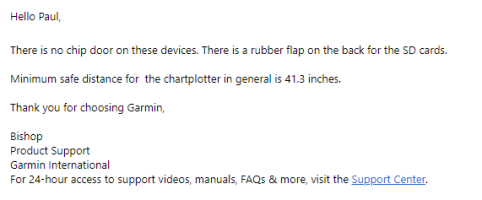
I guess my thinking is now that the compromise thing is massively in play here. To single-hand the boat, stuff needs to be at the helm. The Ritchie compass is at odds with any electronics mounted near it (and varies as the boat heels under it). But, as Christian points out, the iPhone and iPad onboard (along with the Garmin GLo) seem to make up the difference for locating myself (along with the sextant that I don't now how to use yet and my paper charts).
In the event of catastrophic lightning strike, the electronics will have no effect on the Ritchie and it should be good to go?

Last edited:
Thanks! That's helpful to know. As was pointed out, my knowledge may be out of date, at least for one instrument builder.I put in a request at Garmin for more information for one of the most recent Garmin chartplotters and got the response below.
As for their referencing 41 inches of safe distance, I now wonder if that reflects interference they found in testing that relates to energizing of their circuitry?
whether 20 or 40 inches, I imagine that it's way less of a problem for their primary (probably 99%) power boat market where there is lots of surface around the helm location to spread out these instruments and electronics. We sailors have slowly declined into a niche market.....
Marlin Prowell
E34 - Bellingham, WA
This rabbit hole is already too deep, but the Garmin support answer needs to be corrected. First, let's note that Garmin has more than 50 models and variants of GPSMAP chart plotters, from 7" to 27". They obviously don't all have the same compass safe distance of 41.3 inches, but the Garmin response does not name the model(s) that have this compass safe distance.
For the specific Garmin chart plotters discussed here, these are the actual compass safe distances, screenshots taken from a Garmin manual downloaded today:
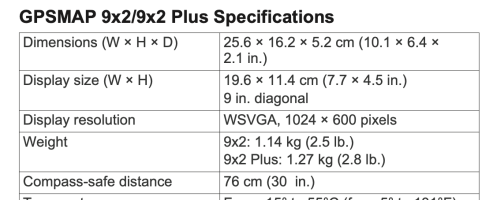
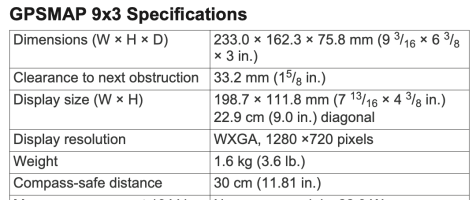
The 9x3 models, which do not have a magnetic SD door, have a much smaller compass safe distance.
So, where did this oddly specific 41.3 inch distance come from? It's the 8616 chart plotter, with a 15.6" diagonal screen. That would be rather large to mount on a binnacle guard.
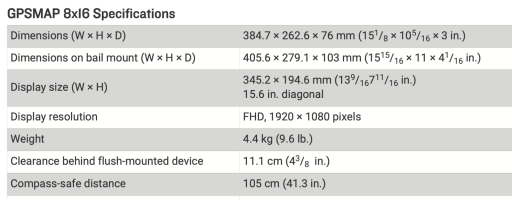
This is actually the very largest compass safe distance for any Garmin chartplotter. Even their 27" models have smaller compass safe distances. The Garmin response is a "safe" response, ignoring what is practical on a sailboat, and therefore totally useless.
The real answer is what several people have already mentioned in previous posts from their real-world experiences.
For the specific Garmin chart plotters discussed here, these are the actual compass safe distances, screenshots taken from a Garmin manual downloaded today:


The 9x3 models, which do not have a magnetic SD door, have a much smaller compass safe distance.
So, where did this oddly specific 41.3 inch distance come from? It's the 8616 chart plotter, with a 15.6" diagonal screen. That would be rather large to mount on a binnacle guard.

This is actually the very largest compass safe distance for any Garmin chartplotter. Even their 27" models have smaller compass safe distances. The Garmin response is a "safe" response, ignoring what is practical on a sailboat, and therefore totally useless.
The real answer is what several people have already mentioned in previous posts from their real-world experiences.
peaman
Sustaining Member
I found this article which discusses "compass safe distance". DO-160 is a standard for testing various characteristics of aeronautic equipment, including certification of magnetic effects. Using DO-160 as a source, the article describes how CSD can be determined, based on causing deflection of a magnetic compass of no more than one degree. I much prefer having a reliable magnetic compass available when underway, but personally, a few degrees off is no big deal, given all of the other variables that must be considered for safe passage.

